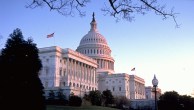A second category of Supreme Court decisions focuses on permanent, rather than seasonal, religious displays that involve some form of government sponsorship. Most of these cases involve displays of the Ten Commandments.
The Stone Decision
The court’s first such decision came in Stone v. Graham (1980), a case that focused on a Kentucky statute requiring public schools to post a copy of the Ten Commandments in every classroom. The state of Kentucky argued that the statute was designed to show students the secular importance of the Ten Commandments as “the fundamental legal code of Western civilization and the common law of the United States.” But the court overturned the statute, concluding that the state lacked a plausible secular purpose for posting what the court saw as “undeniably a sacred text.” An important factor in the court’s decision was the public school setting. Courts have been especially wary of religious activity in the classroom because children are a captive audience and also are more impressionable than adults.
Stone v. Graham (1980)
| Majority: | Minority: |
| Brennan | Blackmun |
| Marshall | Burger |
| Powell | Rehnquist |
| Stevens | Stewart |
| White |
The Supreme Court returned to the issue of government display of the Ten Commandments in two cases decided on the same day in 2005. Rather than leading to clear, consistent rules, however, the sharply divided decisions in these cases further underscored the difficulty of the issues for local and state governments as well as for the courts.
The McCreary County Decision
The first case, McCreary County v. ACLU of Kentucky, involved two Kentucky counties that had posted framed copies of the Ten Commandments in their courthouses. When a lawsuit was filed demanding that the Ten Commandments be removed, the counties expanded the displays to include several additional documents, each of which emphasized the important role of religion in American history and law. After a federal district court ordered the counties to remove the modified displays, the counties added even more documents along with a label:“The Foundations of American Law and Government Display.” The displays included the lyrics to The Star-Spangled Banner as well as the texts of the Declaration of Independence, the Mayflower Compact, the Bill of Rights, the Magna Carta and the preamble to the Kentucky Constitution, plus documents explaining the displays.
Justice David Souter, writing for a 5-4 majority, stated that the two Kentucky counties had a religious purpose in posting the Ten Commandments in the courthouses, thus violating the Establishment Clause. Souter emphasized the principle of government neutrality among religions, and between religion generally and nonreligious beliefs. That principle, he wrote, ensures that religion does not ultimately cause political divisiveness and civic exclusion. The threats of divisiveness and exclusion are especially acute, he said, when government permanently and prominently displays a text that is unquestionably religious.
McCreary County v. ACLU of Kentucky (2005)
| Majority: | Minority: |
| Breyer | Kennedy |
| Ginsburg | Rehnquist |
| O’Connor | Scalia |
| Souter | Thomas |
| Stevens |
Souter argued that courts must determine the predominant purpose of the display as it would be seen and understood by a reasonable observer. In this case, he said, a reasonable observer would conclude that the two Kentucky counties wanted to highlight the religious nature of the Ten Commandments. Souter stated that although the counties attempted to mask this religious purpose by surrounding the Ten Commandments with other documents, those documents failed to create a genuine secular context.
Justice Scalia wrote the dissenting opinion in the case, asserting that the display of the Ten Commandments had a clearly secular purpose – namely, to demonstrate the role of religious teachings in the development of American law. The Establishment Clause, he stated, did not preclude government from recognizing the civic importance of religion. Moreover, he argued, the state should not be prohibited from acknowledging, and even favoring, the widespread belief in a single Creator.
The Van Orden Decision
The second case, Van Orden v. Perry, involved a challenge to the presence on the Texas state Capitol grounds of a stone monument inscribed with the Ten Commandments. The Fraternal Order of Eagles, a primarily secular group that erected similar monuments in other states and cities during the 1950s and 1960s, donated the display to Texas in 1961. It stood on the 22-acre Capitol grounds along with 16 other statues or memorials commemorating significant people and events in Texas history.
[ing]
[its]
Justice Stephen Breyer provided the fifth vote for the majority in Van Orden, but he did not join Rehnquist’s opinion and chose to base his conclusion on narrower grounds. This is important because over the years, the court has consistently ruled that when no single opinion represents a majority of the court, the narrowest opinion that supports the court’s decision is the controlling one. Because Breyer qualified his approval of the Texas monument with a set of limiting conditions, his opinion is narrower than that of the plurality and thus is the most significant guide for the lower courts.
Van Orden v. Perry (2005)
| Majority: | Minority: |
| Breyer | Ginsburg |
| Kennedy | O’Connor |
| Rehnquist | Souter |
| Scalia | Stevens |
| Thomas |
In explaining his vote, Breyer did not focus on the government’s authority to acknowledge religion’s historical role in public life. Instead, he stressed the link between civic tranquility and government neutrality on religion. Breyer wrote that the Free Exercise Clause, which protects the right of religious belief and practice, as well as the Establishment Clause are intended to prevent religion from producing the kind of social conflict that would weaken both religion and government. To guard against such divisiveness, he argued, the government should neither favor nor disfavor any particular religion, or religion generally. But even some versions of neutrality can cause divisiveness, he wrote, as would happen if government sought to be “neutral” by completely banishing religion from public life. Neutrality must be tempered with tolerance for some religious practices that might run counter to an absolutist view of church-state separation. Such tempering, Breyer wrote, cannot be reduced to a simple, clear test; it requires the “exercise of legal judgment.”
Applying such legal judgment to the Texas monument, Breyer acknowledged the religious character of the Ten Commandments text but then evaluated the text’s religious character in light of the setting and the monument’s origins. A primarily secular organization had donated the monument as part of a campaign against juvenile delinquency, and, as already noted, the display was part of a larger, outdoor setting that included other commemorative markers.
Another key factor in Breyer’s opinion was that the Texas monument had generated little controversy during the 40 years it had stood on the Capitol’s grounds. Breyer reasoned that an order to remove the Texas monument – and dozens of similar monuments across the country – would inevitably generate clashes and “thereby create the very kind of religiously based divisiveness that the Establishment Clause seeks to avoid.”
In dissenting opinions, Justices Stevens, Souter, O’Connor and Ruth Bader Ginsburg argued that a reasonable observer would see the monument’s text – with its large heading, “I am the Lord Thy God” – as an endorsement of religion by the state. They contended that the Texas monument was little different from the Kentucky courthouse displays that the court held unconstitutional in McCreary County. In both cases, they argued, the government failed to demonstrate a predominantly secular motive for the displays.
The court’s decisions in these two cases are not easily reconciled. Together, however, the two cases suggest that it is the intent of those who put up a permanent religious display – rather than the display’s effect – that determines if it is permissible. If the evidence points to a predominantly religious purpose, a display is likely to be found unconstitutional. If little or no such evidence is available – as may occur when displays have stood for decades – the courts are more likely to permit them.
Permanent Religious Displays and the Lower Courts
Before the Supreme Court issued its decisions in the 2005 Ten Commandments cases, the lower federal courts took their cues from earlier high-court rulings that emphasized the context of the displays and the perceptions of a reasonable observer.
For example, in Friedman v. Board of Commissioners of Bernalillo County (1985), the 10th U.S. Circuit Court of Appeals upheld a New Mexico county’s use of a seal that included a cross and the phrase, “With This We Conquer.” The court concluded that the seal represented the heritage, history and cultural pride of the county and therefore did not endorse Christianity. In Freethought Society v. Chester County (2003), the 3rd Circuit upheld a Pennsylvania county courthouse’s front-and-center display of a bronze plaque containing the Ten Commandments. In that case, the court stated that a reasonable observer would conclude the plaque did not endorse religious sentiments. The court also stressed the plaque’s significance as a symbol of law, and noted both the plaque’s small size and the near illegibility of the text.
After the Supreme Court’s pair of 2005 decisions in the Ten Commandments cases, however, lower courts changed their focus. They have started considering more closely whether the displays have a predominantly religious purpose – the approach the Supreme Court used in McCreary County. They also are examining more closely the context of the displays and their potential for political divisiveness – as Breyer emphasized in Van Orden.
In 2006, for instance, a panel of the 5th Circuit ruled that a Texas county’s display of an open Bible in a glass-topped case near the entrance of the county courthouse was constitutionally unacceptable. A major factor in the court’s decision in this case, Staley v. Harris County, was the county’s rededication of the monument in 1995, when it was refurbished thanks to efforts by a locally elected judge who had campaigned on the promise of restoring Christian principles to government. The court concluded that those circumstances demonstrated that the Bible display was intended to promote Christianity. In April 2007, after the full 5th Circuit reheard Staley, it dismissed the county’s appeal as moot because the courthouse had been closed for renovations and the Bible monument had been placed temporarily in storage. However, the full court also ruled that the original order barring the display should remain in force, and that the original order’s terms would govern any future display of the monument by the county.
In contrast, in 2005, the 6th Circuit upheld a Ten Commandments display in Kentucky’s Mercer County courthouse. In ACLU of Kentucky v. Mercer County, the court emphasized that the exhibit included 10 other historical documents, including copies of the Magna Carta and the Bill of Rights, all displayed with prominence equal to that given to the Ten Commandments. The court found that the county had established a predominantly secular rather than religious purpose for the display.
In a 2005 case originating in Nebraska, a federal district court as well as the 8th Circuit initially found unacceptable the city of Plattsmouth’s display of a Ten Commandments monument that was donated by the Fraternal Order of Eagles in the 1960s and situated in a public park 10 blocks from City Hall. After the Supreme Court’s decision in Van Orden, however, the Court of Appeals granted a rehearing. By a vote of 9-2, the full appeals court reversed itself, this time approving the Plattsmouth monument.
The 8th Circuit’s opinion in ACLU v. City of Plattsmouth emphasized that similar monuments can be found elsewhere in the United States, and that the Plattsmouth monument had been standing for 35 years before suit was filed. It also noted that the monument is considerably further from any public building than the comparable monument in Van Orden. As a result, the court concluded, the Plattsmouth monument was a “passive acknowledgment of the roles of God and religion in our Nation’s history,” not a government endorsement of religion. Federal district courts have reached a similar conclusion in every subsequent challenge to a monument that was donated by the Fraternal Order of Eagles during the 1960s. In every instance, the district courts followed the principles laid out in Van Orden.
Adding another level of complexity, some cases challenging government religious displays involve state constitutional issues. One such challenge focused on a large Latin cross marking a veterans’ memorial on public property in San Diego. In 15 years of litigation, state and federal courts found the cross to be a violation of the California Constitution, which prohibits religious preferences by the state. In 2002, in Paulson v. City of San Diego, the 9th Circuit ordered authorities to remove the cross. However, the U.S. Congress transferred ownership of the site to the Interior Department in 2006. Therefore, the issue now must be considered only under the U.S. Constitution rather than under the California Constitution. As a result, the Supreme Court blocked the 9th Circuit’s order to remove the cross. Federal courts will now have to consider the original purpose for placing the cross on the site and weigh its religious character against the potential divisiveness of removing it.
Photo credit: Corbis




